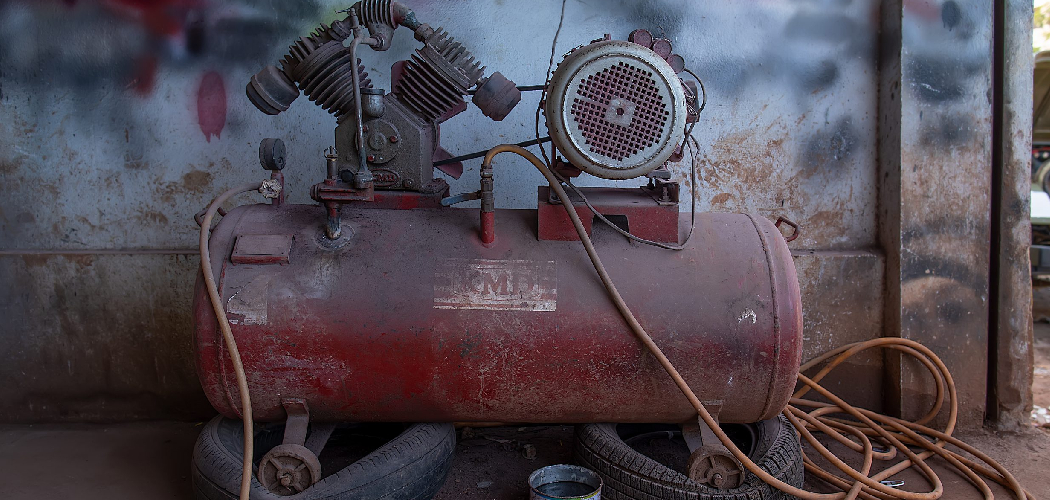It’s no secret that water and air compressors don’t always play nice together. Water can easily damage your compressor, leading to costly repairs or even a replacement. Thankfully, there are some things you can do to help prevent water from entering your compressor and causing damage. In this blog post, we’ll look at how to prevent water in air compressor. Keep reading to learn more!
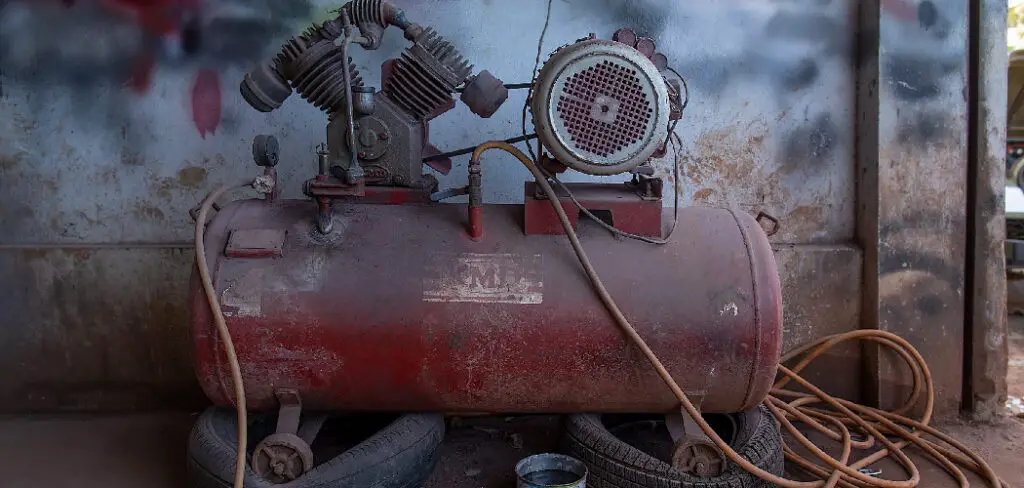
What Causes Water in Air Compressors?
There are a few different ways that water can enter your air compressor. One of the most common is condensation. As air is compressed, it becomes warmer. When this warm air comes into contact with cooler surfaces, like the outside of your compressor, condensation can form. This condensation can then drip into your compressor, causing damage.
Another way water can enter your air compressor is if you’re using an oil-lubricated compressor. The oil in these compressors can break down over time, allowing water to enter and mix with the oil. This can cause problems with your compressor’s lubrication and lead to corrosion. Additionally, if you live in a humid climate, this can lead to condensation inside your compressor.
The other main way water can enter your compressor is simply through leaks. If there are any cracks or holes in your compressor, water can seep in and cause damage. Lastly, using an air compressor in a wet environment, like near a river or ocean, can also lead to water entering your compressor.
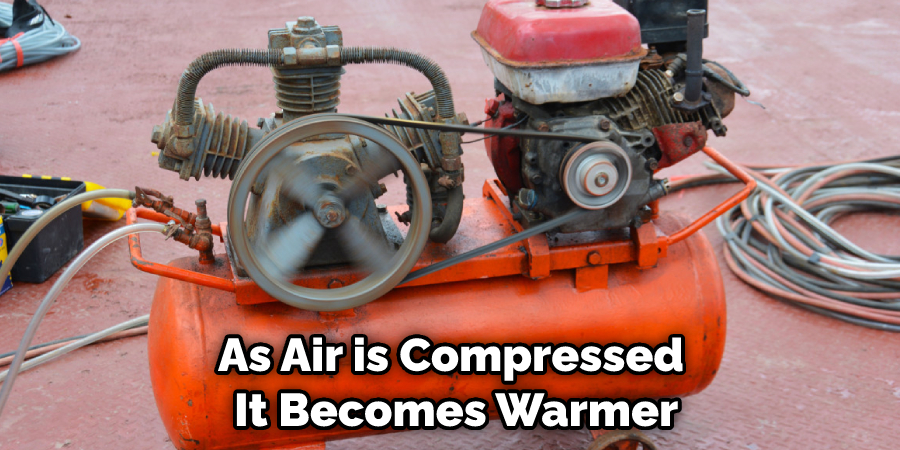
Why It’s Important to Prevent Water in Air Compressors
Water can cause a lot of damage to your air compressor. As we mentioned, it can lead to corrosion and rust, which can shorten the lifespan of your compressor. Additionally, water can cause your compressor to overheat, leading to serious problems. Finally, the filter can also mix with the oil and cause lubrication issues if you’re using an oil-lubricated compressor. All of these problems can be costly to fix and, in some cases, may even require you to replace your compressor.
Another reason to prevent water from entering your air compressor is that it can cause your compressor to fail. If water mixes with the oil in your compressor, it can cause your compressor to seize up. Water entering your air compressor through a leak can short out the electrical components, causing your compressor to fail.
And finally, if water condenses inside your air compressor, it can freeze, causing your compressor to fail. As you can see, water can cause some serious problems for your air compressor. That’s why it’s so important to prevent it from entering your compressor in the first place.
Some Simple Ways How to Prevent Water in Air Compressor
1. Use a Moisture Separator
A moisture separator is one of the best ways to prevent water from entering your air compressor. Moisture separators are devices that remove water from compressed air. They work by allowing the air to cool down before it enters the compressor, which causes the water to condense and separate from the air. As a result, moisture separators effectively prevent water from entering your compressor and causing damage.

2. Use an Air Dryer
Another way to prevent water from entering your air compressor is to use an air dryer. Air dryers remove moisture from the air before it enters the compressor. They work by heating the air, which causes the water to evaporate. Air dryers are very effective at preventing water from entering your compressor and causing damage. To use an air dryer, first, you’ll need to purchase one. You can find air dryers at most hardware stores. Once you have an air dryer, connect it to your air compressor.
3. Use an Inline Filter
An inline filter is another effective way to prevent water from entering your air compressor. Inline filters work by filtering out moisture and impurities from the air before it enters the compressor. Inline filters are very effective at preventing water from entering your compressor and causing damage.
You can purchase inline filters at most hardware stores. To use an inline filter, first, connect the filter to the air intake of your compressor. Next, connect the filter’s air outlet to your compressor’s air inlet. Make sure the connections are tight and secure. Finally, please turn on your compressor and allow it to run for a few minutes to clear any moisture from the system.
4. Use a Water Trap
A water trap is a device that traps moisture in the air before it enters the compressor. Water traps are very effective at preventing water from entering your air compressor and are relatively inexpensive. You can purchase a water trap at most hardware stores. First, locate the air inlet on your compressor to install a water trap. Next, attach the water trap to the air inlet using a pipe or hose.
Finally, connect the other end of the water trap to your air hose. If you are using an air compressor that does not have an air inlet, you can purchase a water trap that attaches directly to your air hose. Avoid using water traps that attach to the outlet of your air compressor, as this can reduce the airflow and cause your compressor to overheat.
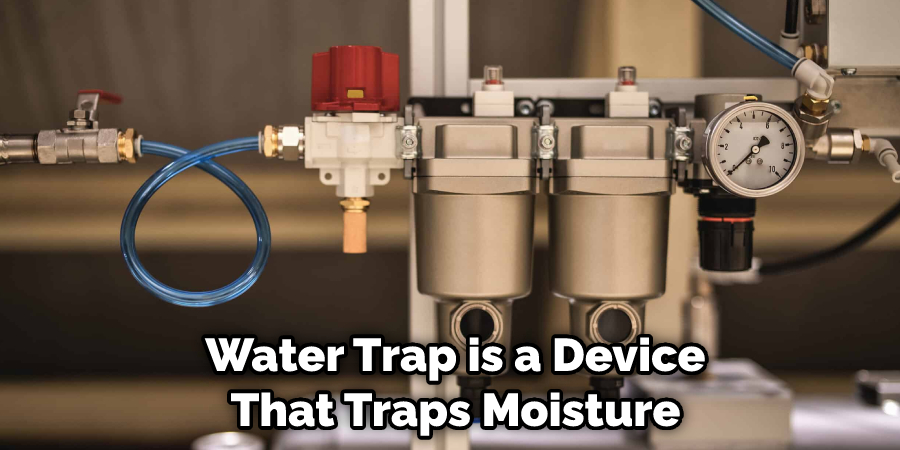
5. Use a Desiccant Air Dryer
A desiccant air dryer is a type of air dryer that uses a desiccant to remove water vapor from compressed air. There are two types of desiccant air dryers: heat regenerative and twin-tower. Heat regenerative air dryers use heat to regenerate the desiccant.
In contrast, twin-tower air dryers use a second desiccant tower to dry the air while the first tower regenerates continually. Desiccant air dryers are very effective at removing water vapor from compressed air and are often used in applications where compressed air needs to be completely dry, such as in food and beverage processing, pharmaceutical manufacturing, and electronics assembly.
6. Keep Your Compressor Room Dry
One of the best ways to prevent water from entering your air compressor is to keep your compressor room dry. If your compressor room is damp or humid, the water will condense on the compressor and enter the air system. Use a dehumidifier or an air conditioner to keep your compressor room dry. First, try the dehumidifier. If the room is still damp, use the air conditioner. Avoid using a humidifier, as this will add moisture to the air and worsen the problem.
7. Locate Your Compressor in a Warm Area
Another way to prevent water from entering your air compressor is to locate your compressor in a warm area. If your compressor is located in a cold area, the cold air can condense the water vapor in the air, which can then enter your compressor. Locating your compressor in a warm area will help prevent this.
Try to find a place for your compressor that is not subject to temperature changes, such as in a garage or shed. Avoid placing your compressor in direct sunlight, as this can cause the compressor to overheat.
8. Insulate Your Compressor
If you live in an area that experiences cold winters, insulating your air compressor can help to prevent water from entering the system. Insulating your compressor will also help to keep the unit running more efficiently.
To insulate your compressor, wrap the unit in a layer of bubble wrap. Next, cover the bubble wrap with a layer of foam insulation. Finally, cover the foam insulation with a layer of heavy-duty plastic. This will help keep the unit warm and dry throughout winter.
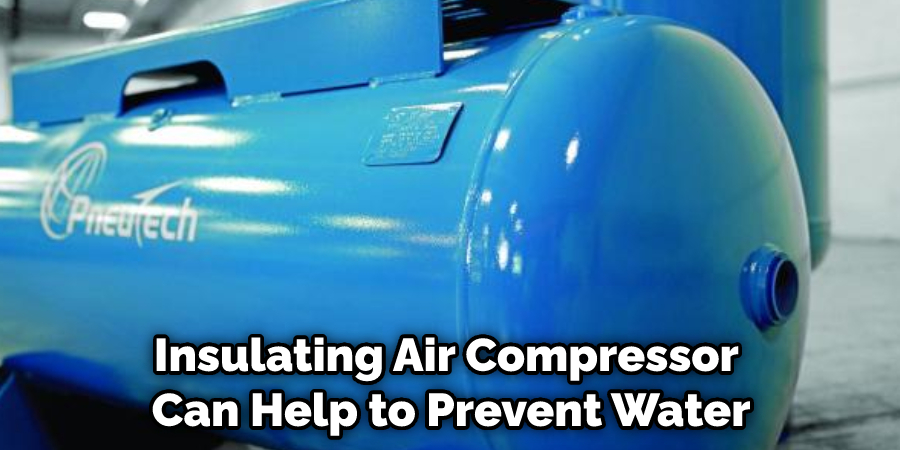
Tips and Warnings on How to Prevent Water in Air Compressor
Tips:
- Inspect your air compressor regularly for moisture. Check the intake filter and discharge port for moisture build-up.
- Be sure to drain your air compressor tank daily. This will help prevent moisture from building up and entering the system.
- Use an air dryer. This will help remove any moisture from the air before it enters your air compressor.
- Store your air compressor in a dry place. This will help prevent moisture from building up and entering the system.
- Insulate your air compressor. This will help keep the unit warm and dry throughout the winter months.
Warnings:
- Do not use an air compressor in a damp or humid area. This can cause water to condense on the compressor and enter the system.
- Do not use a humidifier. This will add moisture to the air and make the problem worse.
- Do not place your air compressor in direct sunlight. This can cause the compressor to overheat.
- Never operate your air compressor without the proper intake and discharge filters in place. This can allow water and other contaminants to enter into the system and damage the compressor.
Conclusion
So there you have it! Now you know how to prevent water in air compressor. Following these simple tips can help keep your air compressor running smoothly and efficiently for years to come. We hope you found this information helpful. If you have any questions, please feel free to contact us. Thank you for reading!
You Can Chack It Out to Hide Window Air Conditioner

